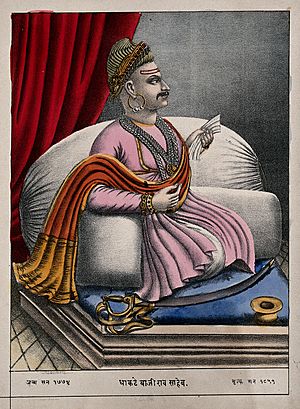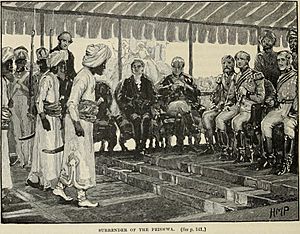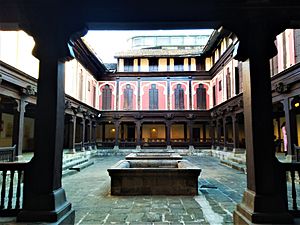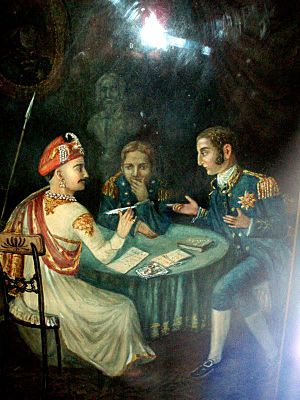Baji Rao II facts for kids
Quick facts for kids
Shrimant Peshwa
Maharajadhiraj Vakil-ul-Mutlaq (Regent of the Empire) Baji Rao II
|
|
|---|---|
 |
|
| In office 6 December 1796 – 3 June 1818 |
|
| Monarch | Shahu II of Satara, Pratap Singh, Raja of Satara |
| Preceded by | Madhavrao II |
| Succeeded by | (Nana Sahib succeeded as a titular Peshwa) |
| Personal details | |
| Born | 10 January 1775 Dhar, Indore State, Maratha Confederacy (present-day Madhya Pradesh) |
| Died | 28 January 1851 (aged 76) Bithur, North-Western Provinces, Company India |
| Spouse | Saraswati Bai |
| Children | Nana Sahib (adopted) |
| Parents | Anandi Bai (mother), Raghunath Rao (father) |
Baji Rao II (born January 10, 1775 – died January 28, 1851) was the 13th and final Peshwa of the Maratha Confederacy. A Peshwa was like a prime minister or chief minister in the Maratha Empire. Baji Rao II ruled from 1795 to 1818. Powerful Maratha nobles put him in charge, but he was mostly a "puppet ruler," meaning others controlled him. Because of this, he fled his capital city, Poona (now Pune), and signed a deal called the Treaty of Bassein (1802) with the British.
This treaty led to the Second Anglo-Maratha War (1803–1805). The British won this war and put Baji Rao back as Peshwa, but with even less real power. Later, in 1817, Baji Rao II fought the British again in the Third Anglo-Maratha War. This happened after the British sided with the Gaekwad nobles in a money dispute. After losing several battles, Baji Rao surrendered. He agreed to retire and live in a special estate at Bithoor and receive a yearly payment.
Contents
Early Life and Challenges
Baji Rao was the son of a former Peshwa, Raghunathrao, and his wife, Anandibai. His father had sided with the English, which led to the First Anglo-Maratha War. Baji Rao was born in 1775 while his parents were held captive by the Peshwa's government.
For 19 years, Baji Rao and his brothers were kept under strict watch. They were not even allowed to get a basic education. Later, after a power struggle among Maratha nobles, Baji Rao II was made Peshwa. However, he faced challenges because his parents were linked to a sad event involving a previous Peshwa, Narayanrao. Because of this, many people, including his ministers and subjects, looked down on him. Even though he was seen as a good administrator and helped build modern-day Pune, some people unfairly called him weak or a coward.
Holkar Takes Poona
After a powerful minister named Nana Fadnavis died in 1800, another general, Daulat Rao Scindia, took full control of the Peshwa's government. As Scindia started removing his rivals, Peshwa Baji Rao II worried about his own safety. He asked for help from the British.
In 1802, Scindia's rival, Yashwant Rao Holkar, marched towards Poona. Holkar said he supported the Peshwa and only wanted to free Poona from Scindia's control. But Baji Rao was nervous because he had previously upset Yashwant Rao's family. He asked Scindia for help, who sent an army to Poona. On October 25, 1802, Holkar defeated the combined forces of the Peshwa and Scindia in the Battle of Hadapsar.
Before the battle, Baji Rao had already started talking to the British about a treaty. After Holkar won, Baji Rao fled to Vasai. He asked the British in Bombay for help. Holkar then set up a temporary government led by Baji Rao's adopted brother, Amrut Rao.
Agreements with the British
In December 1802, Baji Rao II signed the Treaty of Bassein. In this treaty, the British agreed to put Baji Rao II back as Peshwa. In return, Baji Rao had to allow 6,000 British-led infantry troops into Maratha lands. He also had to pay for their upkeep and accept a permanent British political agent, called a Resident, in Poona.
Holkar and Scindia did not like this British interference in Maratha affairs. This led to the Second Anglo-Maratha War from 1803 to 1805. The British won this war. The Marathas lost land because of disagreements among their own leaders, like the Holkars and Scindias. They also faced betrayal from European officers who handled their imported guns.
The Third Anglo-Maratha War

The Pindaris, who were irregular horsemen living in Maratha areas, raided British lands. This eventually led to the Third Anglo-Maratha War from 1817 to 1818. This war ended with the defeat of the Bhosles, Holkars, and other Maratha leaders.
In the mid-1810s, the British got involved in a money dispute between the Peshwa and the Gaekwads of Baroda. On June 13, 1817, the British forced Baji Rao II to sign an agreement. In this agreement, he gave up his claims to Gaekwad's money and gave large areas of land to the British. This treaty, called the Treaty of Poona, officially ended the Peshwa's power over other Maratha chiefs. This also officially ended the Maratha Confederacy.
On November 5, 1817, Baji Rao II's army attacked the British Resident in Poona. Baji Rao watched the battle from a hill now called Parvati. This battle, known as the Battle of Khadki, ended in the Peshwa's defeat.
Afterward, Baji Rao's troops tried to block British forces coming from Jalna. However, one of Baji Rao's chiefs betrayed him, causing his forces to retreat. Baji Rao then captured Chakan Fort from the British. Meanwhile, the British pursued the Peshwa. Towards the end of December, British troops from Shirur met the Peshwa's forces, leading to the Battle of Koregaon. The Peshwa could not defeat the Shirur group and had to retreat when a larger British force approached.
Giving Up and Retiring

Five British groups chased Baji Rao II for five months. He ran from one fort to another, waiting for help from other Maratha leaders that never came. Finally, Baji Rao II surrendered to Sir John Malcolm.
Sir John Malcolm agreed to let Baji Rao remain a prince for life. He could also keep his personal wealth and receive a yearly payment of about £80,000. In return, Baji Rao II had to live in a place chosen by the British, along with his followers. He also agreed never to return to his homeland, Poona. He had to give up all his claims to his old position and could not call himself Peshwa, though he could call himself 'Maharaja'.
The British chose a small village called Bithur, near Kanpur, for Baji Rao II to live. They had a large military base there to keep an eye on him. The area was six square miles, and about 15,000 people lived there, including Baji Rao's relatives and others who moved with him from Poona in 1818. He had once ruled 50 million people.
The British expected Baji Rao II to not live long, but he lived for another 33 years. He died in 1851 in Bithur.
There were many stories about Baji Rao II. One story said that the ghost of a previous Peshwa, Narayan Rao, haunted Baji Rao throughout his life. Narayan Rao was the ninth Peshwa, and it was believed that Baji Rao's parents were involved in his death. To get rid of the ghost, Baji Rao hired priests from Pandharpur. At first, the priests seemed to succeed. Baji Rao II, in thanks, ordered the building of a riverside embankment in Pandharpur, which still has his name.
However, when Baji Rao II was sent to Bithur, the ghost appeared again. Since he could not visit his homeland, he performed many religious acts. He built temples, performed prayers, fasted, and gave money to priests. But the ghost stayed with him until the end. It warned him that his family line would end with his successor, and his home would be destroyed. Later, during the Indian Rebellion of 1857, British troops burned down Bithur, including Baji Rao II's home. Many of his family members, except his adopted son Nana Sahib, lived there.
See also
- Treaty of Poona




